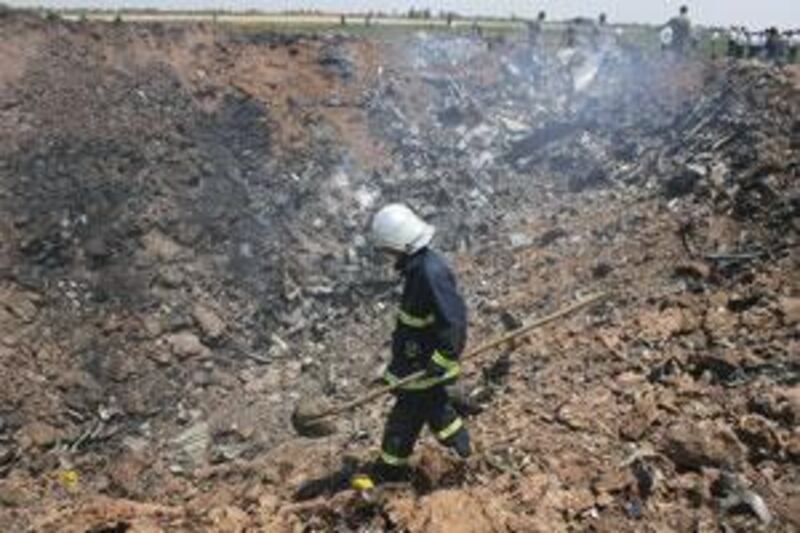All 168 people on board an Iranian passenger plane bound for neighbouring Armenia were killed yesterday when the Russian-built aircraft smashed into farmland north-west of Tehran, gouging out a 10-metre deep crater and spraying smouldering wreckage over a wide area. Local television broadcast harrowing footage from the crash site of items of scorched clothing, footwear and surprisingly pristine identity papers of those who perished. Their number included two children and eight members of Iran's national junior judo team.
Iran has suffered a number of aviation disasters over the past two decades but this was the first in three years and the worst in six. Because of 30-year-old US sanctions, Iran has supplemented its existing fleet of ageing western aircraft with mainly Russian-built planes. These are not subject to the American boycott but many of them also left their factories long ago. The 22-year-old Tupolev 154 exploded after plummeting from the sky and hitting the ground near a picturesque village outside the city of Qazvin shortly before noon. It was just 16 minutes after Caspian Airlines Flight 7908 took off from Tehran's Imam Khomeini international airport.
It was bound for the Armenian capital, Yerevan, carrying 153 passengers and 15 crew members. The cause of the crash was not known and its black box had yet to be found last night. But several witnesses saw the aeroplane's left engine on fire in mid-air. Some said it had circled before crashing, apparently desperately trying to find a suitable emergency landing site near the village of Jannat Abad, 120km north-west of Tehran. Armenian television reported that the crash was caused by an engine fire.
"I saw the plane when it was just above the ground. Its wheels were out and there was fire blazing from the lower parts," said Ablofazl Idaji, an Iranian eyewitness. Qazvin's police commander, Massoud Jafarinasab, said: "The Tupolev plane has been totally destroyed and the corpses, unfortunately, have been totally burnt and destroyed. All on board are dead." Distraught relatives gathered at Yerevan airport where a noticeboard listed those they had expected to hug soon in happy reunions, but who were already dead. An Armenian official said of the 153 passengers that 147 were Iranian, of whom 31 were of Armenian origin. Two Georgian citizens were also among the dead. Iran is home to some 100,000 ethnic Armenians, many of whom frequently use the flights between Tehran and Yerevan to visit relatives.
A spokesman for Iran's Aviation Authority, Reza Jafarzadeh, said no irregularities were reported before the plane took off and insisted no aircraft would be allowed to take flight unless it had been checked rigorously by maintenance workers. State radio said the pilot had not mentioned any technical problem in a taped conversation with a control tower. This was the third fatal crash of a Tupolev 154 in Iran since 2002 and the deadliest air disaster in the country since 2003 when a Russian-built Ilyushin-76 troop carrier crashed in south-eastern Iran, killing all 276 Revolutionary Guard forces and crew aboard.
The Tupolev 154, which is similar in size and structure to a Boeing 727, is mostly in service in countries of the former Soviet Union but is not allowed to fly over Europe because its engines are too loud. Air safety has long been a political issue in Iran, with officials blaming US sanctions for the high frequency of crashes. Boeing Co, the US aircraft manufacturer, has not exported a plane to Iran since 1979. Sanctions have also hampered efforts to buy spare parts for US planes bought earlier or to acquire European planes powered by US-built engines such as Airbus airliners. Iranian pilots have been known to smuggle home spare parts bought during trips to Europe in their cockpits.
American sanctions, however, do not apply to aircraft from Russia or Ukraine and Iran is starting joint ventures with both countries to rebuild its civil aviation fleet. Caspian Airlines, based in Tehran, was established in 1993 and flies an all-Tupolev fleet linking Iranian cities. It also has routes to the UAE, Ukraine and Armenia. Aviation experts said the small, private company has a relatively good safety record.
The Iranian authorities are sensitive to domestic criticism that they are not doing more to maintain or replace ageing aircraft and yesterday's tragedy will increase such concerns. In December 2005, a group of parliamentarians sought the dismissal of the defence minister after a military C-130 transport plane, bought from the US three decades earlier, crashed into a 10-storey apartment building shortly after taking off from Tehran's Mehrabad airport.
It was carrying scores of journalists to cover military exercises in the south of the country. Ninety-four people died on board and at least 22 more were killed on the ground as flaming wreckage rained onto the streets. Some newspapers and the families of victims claimed that officials knew before take-off that the plane had technical problems. The following September, 29 people were killed when a Russian-built Tupolev 154 crash-landed on an airport runway in the north-eastern Iranian city of Mashhad and burst into flames. Another 43 people were injured. Two months later, in November 2006, a Russian-designed Antonov-74 military plane crashed on take-off at Tehran's Mehrabad airport, killing all 39 people on board, including 30 members of the elite Revolutionary Guards.
@Email:mtheodoulou@thenational.ae





